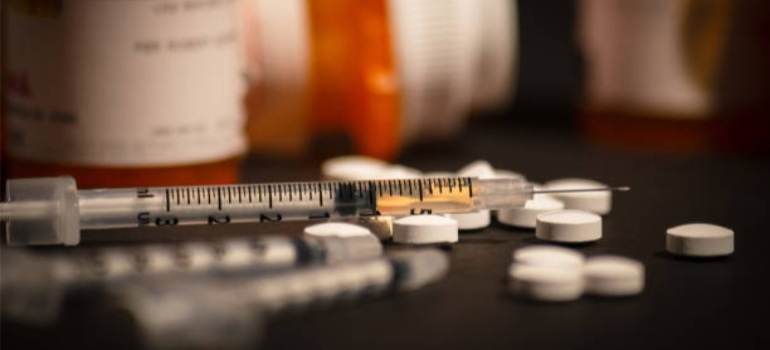The Alarming Rise of Drug Overdoses in the US: A Comprehensive Overview
Get Help Now
In recent years, the country has witnessed a distressing surge in drug-related deaths, posing significant challenges to public health and well-being. The rise of drug overdoses in the US is a pressing issue that demands immediate attention. Disturbing statistics reveal the magnitude of this crisis, with devastating consequences affecting individuals, families, and communities nationwide.
As the premier detox clinic in Florida, we understand the gravity of this phenomenon well. In this comprehensive overview, we will delve into the rise of drug overdoses in the US, shedding light on the factors fueling this crisis.
The Rise of Drug Overdoses in Different States
Initially, we should quantify this concerning phenomenon that demands attention. Indeed, statistics reveal the varying rates of drug overdose deaths across the country.
Among the states with the high overdose rates, Maryland stands out with the greatest overdose death rate among all deaths. California, on the other hand, has the highest number of drug overdose deaths. Regional variations in drug overdose rates are apparent, particularly in the Northeast, where a concentration of high rates can be found, spanning the Great Lakes and Mid-Atlantic regions.
These regional differences highlight the complex nature of the drug overdose crisis in the US. While some states experience higher rates, it is important to note that drug overdose deaths have been a pervasive issue across the country.
The devastating impact of drug overdoses affects individuals, families, and communities nationwide. Understanding the regional variations and trends is crucial for developing targeted interventions and addressing the underlying factors contributing to the rise of drug overdoses.
Research and data analysis play a crucial role in identifying these trends and understanding the dynamics at play. By examining the varying rates of drug overdose deaths in different states, policymakers, healthcare professionals, and communities can gain insights into the underlying factors and tailor interventions accordingly. This data-driven approach allows for targeted strategies and resource allocation to the areas most affected by the rise of drug overdoses. Understanding the regional variations makes it possible to develop comprehensive and region-specific approaches to prevention, treatment, and support for individuals struggling with substance abuse.

Factors Contributing to the Rise
Regional variance aside, there are ample factors that also contribute to the rise of drug overdoses in the US. The most notable ones include the following.
The opioid crisis
Opioids, including prescription painkillers, heroin, and synthetic opioids like fentanyl, have contributed to the devastating overdose crisis gripping the nation. These highly addictive substances have a potent effect on the central nervous system, leading to a higher risk of overdose. This is why opioid withdrawal treatment tends to be more extensive than most.
Opioids act on the brain’s receptors, suppressing pain and producing a sense of euphoria, but they also depress the respiratory system, making overdose a life-threatening possibility. The increased availability and misuse of prescription opioids, coupled with the influx of illicit opioids like heroin and fentanyl, have fueled the epidemic.
Furthermore, the potency and lethal nature of synthetic opioids, which are often mixed with other substances, pose a grave danger to individuals using drugs, contributing to the rising overdose rates. To address the drug overdose crisis, it is crucial to tackle the underlying opioid epidemic through comprehensive strategies that involve education, prevention, access to evidence-based treatment, and harm reduction initiatives.
The potency of synthetic opioids
Synthetic opioids in particular also play a crucial role in the rise of drug overdoses in the US, primarily due to their potency. Synthetic opioids, such as fentanyl and its analogs, are powerful substances that can be 50 to 100 times more potent than morphine.
These synthetic opioids are often illicitly manufactured and added to other drugs, including counterfeit prescription pills and illicit substances like heroin and cocaine. For this reason, cocaine withdrawal treatment may have to address fentanyl use as well.
Because of their potency, even minuscule amounts of synthetic opioids can be fatal. Users may unknowingly consume drugs laced with fentanyl, increasing the risk of overdose and death. The presence of synthetic opioids in the illicit drug market has created a dangerous environment, where individuals seeking substances for recreational use or pain relief are at high risk of unintentionally consuming lethal doses. Addressing the potency of synthetic opioids requires a multi-faceted approach, including increasing awareness, improving drug testing capabilities, enhancing drug education and prevention efforts, and expanding access to naloxone, a life-saving opioid overdose reversal medication.

Prescription drugs
The increased availability and misuse of prescription drugs have also been significant factors contributing to the crisis. Prescription drugs, such as opioid painkillers, stimulants, and sedatives, have become more readily accessible due to factors like overprescribing, diversion, and illicit sales. Xanax detox Florida programs have seen a rise in demand for this reason.
Many individuals obtain prescription drugs from family, friends, or through illegal means, without a legitimate medical need. The misuse of these medications involves taking them in higher doses or for longer durations than prescribed, or using them recreationally. This misuse can lead to dependence, addiction, and an increased risk of overdose.
Additionally, the opioid crisis has been fueled by the addictive nature of prescription opioids, with individuals transitioning to illicit opioids like heroin or fentanyl when access to prescription drugs becomes restricted. Efforts to address the availability of prescription drugs include enhancing prescription monitoring programs, promoting responsible prescribing practices, increasing public awareness about the dangers of misuse, and improving access to substance abuse treatment and support services.
Mental health and substance use
Finally, the connection between mental health and substance use is also a critical factor contributing to the rise of drug overdoses in the US. Substance abuse often co-occurs with mental health disorders, creating a complex and challenging situation for individuals. This is what is known as “dual diagnosis”, which detox inpatient Florida programs often need to cater to.
Many individuals turn to drugs or alcohol as a way to cope with mental health symptoms such as anxiety, depression, or trauma. Substance use can temporarily alleviate these symptoms, leading to a self-medicating pattern that can quickly spiral into addiction. Dual diagnosis requires a comprehensive approach to treatment that addresses both the mental health condition and substance abuse simultaneously.
Failing to address the underlying mental health issues can increase the risk of relapse and contribute to the rise of drug overdoses. To combat this, integrated treatment programs that combine therapy, medication management, and support services are essential to effectively address both the mental health and substance use aspects of an individual’s well-being. Furthermore, destigmatizing mental health and improving access to mental health services can help prevent the dangerous cycle of self-medication and reduce the risk of drug overdoses.

Public Health Implications
Given its scope, the rise of drug overdoses in the US has profound public health implications, impacting individuals, families, and communities across the nation. Drug overdoses have devastating consequences, leading to the loss of countless lives and leaving families and loved ones in grief and despair.
The burden on healthcare systems and emergency services is significant, as the surge in overdoses strains resources and personnel. Healthcare providers and emergency responders face the challenge of managing the immediate life-threatening emergencies caused by overdoses while also addressing the underlying issues of substance abuse and addiction. The long-term health effects for survivors of overdoses can be severe, ranging from organ damage and infectious diseases to neurological and psychological complications. The Lancet reports that in 2017, between 35 and 72 million people globally had drug use disorders, indicating the long-lasting impact on individuals’ health.
Moreover, the COVID-19 pandemic has further exacerbated the crisis, with a spike in overdose deaths and disruptions in addiction treatment and support services. The public health implications extend beyond the individuals directly affected by overdoses, affecting communities as a whole. Drug-related crimes, social instability, and economic burdens are common consequences of the rise in drug overdoses. It is crucial for public health initiatives to prioritize prevention, harm reduction, and access to comprehensive treatment and recovery services. By addressing the root causes of substance abuse and implementing evidence-based interventions, communities can work towards reducing the devastating impact of drug overdoses and promoting the well-being of individuals and society as a whole.

Government and Policy Response
Thankfully, the rise of drug overdoses in the US has prompted significant government and policy responses at both federal and state levels. Recognizing the urgency of the crisis, the Biden administration released the inaugural National Drug Control Strategy, outlining a comprehensive path forward to address addiction and the overdose epidemic.
Harm reduction strategies have gained prominence as a key approach in combating overdoses. One such strategy is the distribution of naloxone, an opioid overdose reversal medication, to first responders, community organizations, and individuals at risk.
Another innovative approach is the establishment of safe injection sites, where individuals can use drugs under medical supervision, reducing the risk of fatal overdoses and facilitating access to healthcare and addiction treatment services. However, the implementation of harm reduction strategies faces legal and political challenges, with debates over their efficacy and concerns about potential unintended consequences.
Enforcing drug laws and combatting drug trafficking present ongoing challenges, as criminal organizations continue to exploit the demand for illicit substances. The focus has shifted towards a public health-oriented approach, aiming to address the root causes of substance abuse and provide treatment and support to individuals struggling with addiction. Government responses are informed by research and statistics that highlight the gravity of the crisis.

Rise of Drug Overdoses in the US: Rehab Challenges
However, the crisis has placed immense pressure on addiction treatment and rehabilitation services, presenting a range of challenges. The overwhelming demand for these services has strained existing rehabilitation centers, making it difficult to accommodate all those in need of treatment.
Rehabilitation centers face limitations and barriers, such as financial constraints, limited staff and resources, and the need for comprehensive and evidence-based treatment approaches.
Additionally, there is a shortage of treatment facilities and resources, exacerbating the difficulties in providing timely and accessible care for individuals seeking help.
Aftercare and relapse prevention pose further challenges, as sustained support and follow-up are crucial for successful recovery. However, the continuity of care is often disrupted due to various factors, including a lack of comprehensive aftercare programs and limited access to ongoing support services.
It is essential to address these challenges in order to meet the needs of individuals in recovery and reduce the risk of relapse. To improve the situation, strategic investments in expanding treatment capacity, strengthening the workforce, and implementing evidence-based practices are necessary. Research and statistics emphasize the urgency of these efforts. The growing number of drug overdose cases underscores the importance of effective rehabilitation and aftercare services in saving lives and promoting long-term recovery.
By addressing the limitations and barriers faced by rehabilitation centers, increasing access to treatment facilities and resources, and prioritizing comprehensive aftercare and relapse prevention, it is possible to enhance the effectiveness of addiction treatment and rehabilitation, leading to improved outcomes and better support for individuals affected by drug overdoses.

Solutions to the Rise: Innovations in Rehab
Finally, innovations in rehab offer potential solutions to the rise of drug overdoses in the US, providing hope for effective addiction treatment. One promising approach is medication-assisted treatment (MAT), which combines medications like methadone, buprenorphine, or naltrexone with counseling and behavioral therapies to address opioid addiction. MAT is the approach that drug detox Florida programs tend to lean on.
Cognitive-behavioral therapy (CBT) and counseling play a vital role in rehab programs, helping individuals develop coping strategies, identify triggers, and modify destructive behaviors.
Studies also find that peer support and community involvement are also essential, as they provide individuals with a sense of belonging, understanding, and accountability during the recovery process.
Moreover, technology and telemedicine have the potential to expand access to rehab services by enabling remote consultations, monitoring, and support, particularly in areas with limited resources or during times of crisis.
These innovations can bridge the gap between individuals in need and the necessary treatment. However, it is crucial to recognize that addiction is a complex issue influenced by various factors. Comprehensive, multidisciplinary approaches that address the underlying causes of addiction, including social, psychological, and environmental factors, are essential for successful rehabilitation.
By integrating these innovative approaches and emphasizing a holistic view of addiction treatment, we can make significant progress in combating the rise of drug overdoses, reducing harm, and promoting long-term recovery. Statistics and research highlight the effectiveness of these strategies in reducing drug use, improving individuals’ functioning, and decreasing crime rates.
With continued investment in research and the implementation of evidence-based practices, innovations in rehab can offer a pathway towards addressing the devastating impact of drug overdoses in the US.
Conclusion
In conclusion, the alarming rise of drug overdoses in the US demands immediate attention and action. The prevalence of drug overdoses, particularly those involving synthetic opioids like fentanyl, has reached critical levels, resulting in numerous deaths on a daily basis. The relentless increase in drug overdoses highlights the urgent need for comprehensive strategies and interventions to address this public health crisis.
By raising awareness, improving access to addiction treatment, and enhancing support systems, we can strive to reverse this devastating trend and save lives. The drug overdose epidemic is a grave concern that necessitates a concerted effort from all stakeholders to protect the well-being and future of our communities.